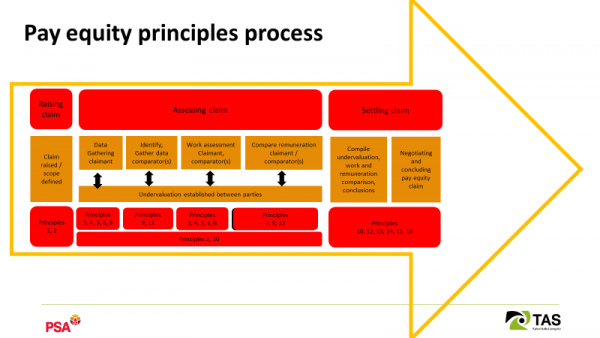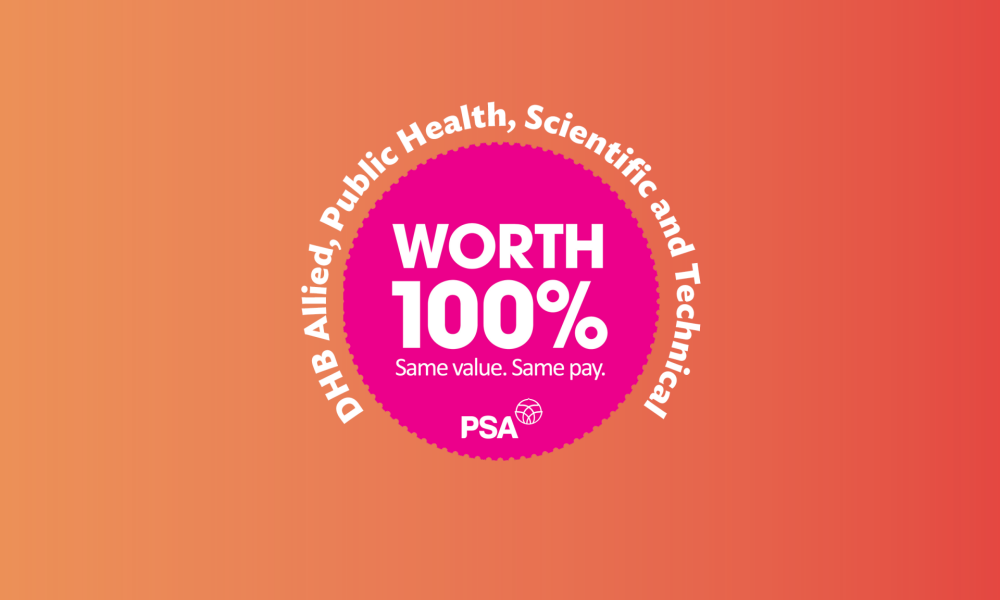The claim makes the case that employees in female dominated occupations have had their work undervalued because that work has traditionally been ‘women’s work’. We also have a claim for Radiation Therapists raised in mid 2019 which is now part of the larger claim.
The DHBs have accepted our claim and agree that this work in DHBs is predominantly done by women and it is arguable that the work is currently and/or historically been undervalued, while noting that agreeing to proceed with a pay equity claim does not in itself predetermine a pay equity outcome.
In the few instances where the occupations under our coverage are not female dominated, we have advised the DHBs that if under valuation is identified (as we expect) in the female dominated occupational groups then in the settlement phase we will seek to ensure male dominated occupations maintain pay parity with the groups they currently have a relativity with.
Latest update - dated 25 May 2022
Round one (1) questionnaires have been returned and are being turned into profiles now. This is proceeding rapidly and we will be meeting with member reference groups shortly to review the profiles and ensure they fully describe the work that you do.
The questionnaires supplement interviews that took place previously. For efficiency we are targeting which DHBs we send questionnaires to capture a cross section of work e.g. rural, urban, large, small etc (all workers within the profession at the representative DHB are being sent the questionnaires).
Round one (1) included large groups of workers across a range of DHBs:
|
A&OD |
Occupational Therapist |
|
Assistants (incl Dental) |
Physiotherapist |
|
Dental/Oral Health Therapist |
Psychologist |
|
Dietitian |
Social Worker |
|
Health Promoter |
Speech & Lang Therapist |
|
Health Protection |
Scientific & Technical group |
|
Needs Assessor/Coord |
|
Round two (2) of questionnaires has now been sent with the closing date 30th May:
|
Audiologist |
Physicist |
|
Community Support Worker |
Play Specialist |
|
Counsellors |
Podiatrist |
|
Medical Imaging Technologist |
Recreation and Welfare Officers |
|
Medical Radiation Therapist |
Sonographer |
|
Optometrists |
|
There will be a third round of questionnaires sent to capture any roles not covered above.
What’s next?
Once this process is complete we will have a range of profiles that describe the kinds of work covered by the claim to be compare with male dominated work to understand any undervaluation. If undervaluation is identified then we move into negotiating a settlement to your claim.
What can I do?
To be successful we need Allied Health workers to be unionised, members need to encourage co-workers to join the PSA, so we are strong as we work for equity. Look out for more information and opportunities to get involved in future updates.
Background information
The PSA has raised a pay equity claim for Allied Health, scientific and technical DHB workers. Even though the claim is complex - covering over 70 professions and 11,000 FTE - we are stronger together. If we had put in separate claims for each occupation, it could take years to do each one in turn.
In December 2019 PSA and the DHBs agreed a Terms of Reference for the APHT pay equity process.
Occupational reference groups were set up, made up of active PSA members, who will be the brains trust and experts for each occupation as we go through the pay equity assessment process.
A PSA Oversight Group was also established, made up of PSA representatives whose job it is to be directly involved at a national level, representing all members and keeping in touch with the reference groups. This group has been meeting with DHB reps.
In 2021 we interviewed across a number of roles and established a better sense of the variety of roles within the claim, including variation between DHBs and different levels, specialties, and context within the different occupations. To ensure we accurately gather the information about the different skills, responsibilities, efforts, demands and conditions across the work covered by the claim we have now started the process of gathering wider information through questionnaires (the first round have now been sent to a selection of DHBs and have focussed on pharmacy, with other groups to follow shortly. We will use the questionnaire data to both gather the information we need about variation in the work, and ensure we are able to fully understand bench mark roles (including but not limited to practitioner, advanced practitioner, specialist, professional lead, technician, assistant, team leader etc.
The purpose of this work is to ensure we gather the information we need as efficiently as possible, without missing anything we need to fully understand how undervaluation has impacted the roles covered by the claim.
Related documents
-
20191205 DHB APHT Bargaining Process Terms of Settlement SIGNED Adobe Acrobat PDF file | 1 MB
-
2020090 DHB APHT Initiation of bargaining Auckland Adobe Acrobat PDF file | 178 KB
-
2020090 DHB APHT Initiation of bargaining RONZ Adobe Acrobat PDF file | 187 KB
-
211005 DHB APHT MECAs Letter of Offer SIGNED Adobe Acrobat PDF file | 1.2 MB
-
FLYER Intro to DHB APHT Pay Equity Adobe Acrobat PDF file | 615 KB
-
PSA MECA AlliedPublicHealthTechnical 2018 2020 Auckland Adobe Acrobat PDF file | 6.5 MB
-
PSA MECA AlliedPublicHealthTechnical 2018 2020 RoNZ Adobe Acrobat PDF file | 8 MB
About the pay equity claim
The diagram below sets out the stages of the processes we need to follow to settle our claim:

Of all the claims filed so far in the DHBs (including Clerical Admin and Nursing) this claim is perhaps the most complex due to the large number of occupational groups it covers. However, the work and data that will already have been collected in the other claims will expedite this claim.
The Pay Equity Group comprises representatives from Te Kawa Matahoo (Public Service Commission), Treasury, the Department of the Prime Minister and Cabinet, and relevant government ministries (MOH or Education) to oversee all the claims.
The Government has also appointed a Crown Negotiator who will be working with them, the DHBs, and the governance group to settle the claims once undervaluation has been identified.
What is Pay Equity?
Our equal pay laws say that women and men should be paid equal pay for work of equal value. This is called pay equity. If a female dominated occupation has the same or similar skills, effort, conditions of work and qualifications as a male dominated occupation, then they should be paid the same.
Pay equity differs from ‘equal pay’. Equal pay means two people who are doing the same job should be paid the same regardless of their gender. Pay equity also differs from pay parity. Pay parity is the same pay for the same job across different employers or workplaces (e.g. receptionists at one DHB or within a DHB should both be paid the same).
What has happened so far?
PSA lodged a claim for all occupational groups covered by the APHT MECAs in our last bargaining. Even though the claim is complex - covering about 60 professions and 11,000 FTE - we are stronger together. If we had put in separate claims for each occupation, it could take years to do each one in turn.
In December 2019 PSA and the DHBs agreed a Terms of Reference for the APHT pay equity process.
We have now set up occupational reference groups made up of active PSA members, who will be the brains trust and experts for each occupation as we go through the pay equity assessment process.
We have also established a PSA Oversight Group made up of PSA representatives whose job it is to be directly involved at a national level, representing all members and keeping in touch with the reference groups. That group has begun meeting with DHB reps in this process.
In 2021 we interviewed across a number of roles and established a better sense of the variety of roles within the claim, including variation between DHBs and different levels, specialties, and context within the different occupations. To ensure we accurately gather the information about the different skills, responsibilities, efforts, demands and conditions across the work covered by the claim we have now started the process of gathering wider information through questionnaires (the first round have now been sent to a selection of DHBs and have focussed on pharmacy, with other groups to follow shortly. We will use the questionnaire data to both gather the information we need about variation in the work, and ensure we are able to fully understand bench mark roles (including but not limited to practitioner, advanced practitioner, specialist, professional lead, technician, assistant, team leader etc.
The purpose of this work is to ensure we gather the information we need as efficiently as possible, without missing anything we need to fully understand how undervaluation has impacted the roles covered by the claim.
What are the key stages of the pay equity claim process?
In broad terms, the key stages of the pay equity claim process are:
(1) Investigating the work being done by APHT occupations (claimants) and comparators (male-dominated occupations) using a gender-neutral tool.
(2) Assessing remuneration for the claimant and comparator roles,
(3) If undervaluation of the claimant roles is established, negotiating an outcome for the pay equity claim.
What roles will be assessed in the Allied, Public Health, Scientific and Technical claim?
We will be interviewing PSA members in a sample of roles at a number of locations and different sized DHBs.
We cannot interview every PSA member nor can we review every position. This would take a very long time, since we are looking at historical and current undervaluation due to gender, we don’t need to do this in order to get the information we need.
Interviewing this sample will establish the value of the roles and then consider the degree of undervaluation that is present (i.e. what the equal pay rate should be).
What can you do?
Spread the word, talk about it with your colleagues, come to pay equity meetings, keep up to date with progress, be active in your workplace to help keep momentum in this historical process.
